- Joined
- Oct 14, 2014
- Messages
- 2,099
- Points
- 113
- Age
- 59
- Location
- Pueblo West, Colorado
- Website
- lnlpublishing.com
We have printed (and played) a number of Hex & Counter war games, and made lots of expansion counters and scenarios for games I already own. I have developed tested methods, which make the process crazy quick and stupid simple. Might as well share what I know. We are using a standard Print n Play game using Checkpoint Calvi as an example, since the basics apply to any PNP Hex & Counter game.
The expanded Checkpoint Calvi scenario is a 14-page PDF, although three pages are repeated. Included are the scenario itself, the 6 pages of maps, a page for map overlays, and the counter sheet.
The scenario instructions and terrain effects chart are easily printed on cardstock, (Note: Exception some games may require that the paper be scaled “Fit to Printable Area” so as to not cuff off the top and bottom. Some whole documents prints better that way, EXCEPT for the counters, which are best with no scaling (select “None”) Most LnLP products will not need to be scaled.
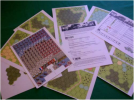
Typically, I print maps (these are better printed on a laser printer when available) photo glossy card, which looks best and usually lay flat. These scenario maps are not very detailed, and will be played under Plexiglass, so I just use my inkjet on card stock paper. Remember you can always go and have them printed at Office Depot. An advantage of PNP is I can try stuff, and change things after the fact.
Because the scenario has six maps that abut each other, I cut off the excess margins (ooh, scissors, cutting in straight lines!). The only tricky part is the overlays, but they cut out just fine. That’s it, ALL the paperwork is done. Yes, if I were making an entire PNP game, there would also be a rulebook to print up. Please remember LnL also provides E-Pub rulebooks so you can use your iPad or tablet device for reading.
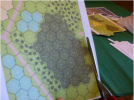
With PNP, sometimes counter sheet scaling can be tricky. Get it wrong and the counters are too small or too large. I often print up quick B&W examples on regular paper, trying different printer scaling. And then check them against right-sized official counters. For Checkpoint Calvi, “None” is the perfect scale setting. The counter sheet has 89 counters, front and back, two full “armies” for free (not counting the cost of production, which ain’t much). To make good-looking counters, I laser print them on glossy photo paper (first choice), or use a high quality ink jet with best photo settings (caution, that uses lots of ink). An alternative is having Office Depot print them. Cost like 1.19 per page.
OK, all the components are printed. The scenario and TEC chart are done. Here comes the scary part, making the counters. We need two high tech devices: Plain scissors, and Elmer’s Spray Adhesive ($7 at Office Depots). Cut the counter sheet into separate halves--the front and back sheets of the double-sided counters. Then cut those into easy to use “blocks,” (5x10 counters, or thereabouts). Too big is difficult to align, too small gets your fingers tacky with glue. Both tend to slow down production.
Now I matched the blocks of counters to cardboard. I spare no expense and use the cardboard back sheets from yellow writing pads ($7 for 12 pads). I should probably go to an art store and buy proper cardboard, but why make a separate trip? Again, fearlessly using those same scissors, I use the counter blocks as a “guide” to cut the cardboard to size. What you see here is the most demanding task of the entire endeavor. No measuring, no precision, just hold the counter block up to the cardboard and cut.
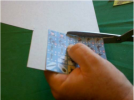
Time to do some gluing. Others advocate adhesive label paper, but it’s kinda pricey. And, you have to be precise when mounting the counters. I’m very satisfied with my Elmer’s Spray Adhesive. I get the kind that “Allows for Adjustment,” not the Quick Dry. I have had only one can go bad on me; the top came off and would not refit. But, I’ve had plenty of cans work very well for various projects. I don’t need a gas mask, it’s non-toxic and safe indoors. I use the yellow paper from the writing tablet as an over spray catcher. Spray the cardboard liberally and apply the counter block. Press between sheets of paper to get rid of air bubbles and smooth it out.
Over the intervening years I've tried my hand at using adhesive label paper. It works great, too. Turns out you do get a second chance to align the paper, because it does not stick immediately. It is faster than spray glue. But does not print as picture perfect or glossy as laser gloss paper. You can make high quality counters with label paper, but I use the label paper for single sided counters. And, for games with counters that are not detailed, like most operational and strategic games.
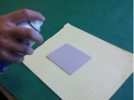
When the counter blocks are dry, repeat for the backside.
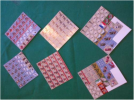
The same dang scissors to cut the counter blocks along the alignment lines of the counters. I made 89 perfect counters.
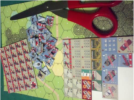
Guess what? Done! Cheap, easy, quick and good looking. What more could a gamer wish for? That wasn't so scary, was it? My goal here is to encourage PNP, because I remember wishing I knew how to make counters to expand my World at War tactical games with fan created additions. I was surprised how easy and quick it is to make high quality components for games and expansions.
- Mark Mitchell
The original article was written by Mark Mitchell also known as ZombieMark on BGG.
The expanded Checkpoint Calvi scenario is a 14-page PDF, although three pages are repeated. Included are the scenario itself, the 6 pages of maps, a page for map overlays, and the counter sheet.
The scenario instructions and terrain effects chart are easily printed on cardstock, (Note: Exception some games may require that the paper be scaled “Fit to Printable Area” so as to not cuff off the top and bottom. Some whole documents prints better that way, EXCEPT for the counters, which are best with no scaling (select “None”) Most LnLP products will not need to be scaled.

Typically, I print maps (these are better printed on a laser printer when available) photo glossy card, which looks best and usually lay flat. These scenario maps are not very detailed, and will be played under Plexiglass, so I just use my inkjet on card stock paper. Remember you can always go and have them printed at Office Depot. An advantage of PNP is I can try stuff, and change things after the fact.
Because the scenario has six maps that abut each other, I cut off the excess margins (ooh, scissors, cutting in straight lines!). The only tricky part is the overlays, but they cut out just fine. That’s it, ALL the paperwork is done. Yes, if I were making an entire PNP game, there would also be a rulebook to print up. Please remember LnL also provides E-Pub rulebooks so you can use your iPad or tablet device for reading.

With PNP, sometimes counter sheet scaling can be tricky. Get it wrong and the counters are too small or too large. I often print up quick B&W examples on regular paper, trying different printer scaling. And then check them against right-sized official counters. For Checkpoint Calvi, “None” is the perfect scale setting. The counter sheet has 89 counters, front and back, two full “armies” for free (not counting the cost of production, which ain’t much). To make good-looking counters, I laser print them on glossy photo paper (first choice), or use a high quality ink jet with best photo settings (caution, that uses lots of ink). An alternative is having Office Depot print them. Cost like 1.19 per page.
OK, all the components are printed. The scenario and TEC chart are done. Here comes the scary part, making the counters. We need two high tech devices: Plain scissors, and Elmer’s Spray Adhesive ($7 at Office Depots). Cut the counter sheet into separate halves--the front and back sheets of the double-sided counters. Then cut those into easy to use “blocks,” (5x10 counters, or thereabouts). Too big is difficult to align, too small gets your fingers tacky with glue. Both tend to slow down production.
Now I matched the blocks of counters to cardboard. I spare no expense and use the cardboard back sheets from yellow writing pads ($7 for 12 pads). I should probably go to an art store and buy proper cardboard, but why make a separate trip? Again, fearlessly using those same scissors, I use the counter blocks as a “guide” to cut the cardboard to size. What you see here is the most demanding task of the entire endeavor. No measuring, no precision, just hold the counter block up to the cardboard and cut.

Time to do some gluing. Others advocate adhesive label paper, but it’s kinda pricey. And, you have to be precise when mounting the counters. I’m very satisfied with my Elmer’s Spray Adhesive. I get the kind that “Allows for Adjustment,” not the Quick Dry. I have had only one can go bad on me; the top came off and would not refit. But, I’ve had plenty of cans work very well for various projects. I don’t need a gas mask, it’s non-toxic and safe indoors. I use the yellow paper from the writing tablet as an over spray catcher. Spray the cardboard liberally and apply the counter block. Press between sheets of paper to get rid of air bubbles and smooth it out.
Over the intervening years I've tried my hand at using adhesive label paper. It works great, too. Turns out you do get a second chance to align the paper, because it does not stick immediately. It is faster than spray glue. But does not print as picture perfect or glossy as laser gloss paper. You can make high quality counters with label paper, but I use the label paper for single sided counters. And, for games with counters that are not detailed, like most operational and strategic games.

When the counter blocks are dry, repeat for the backside.

The same dang scissors to cut the counter blocks along the alignment lines of the counters. I made 89 perfect counters.

Guess what? Done! Cheap, easy, quick and good looking. What more could a gamer wish for? That wasn't so scary, was it? My goal here is to encourage PNP, because I remember wishing I knew how to make counters to expand my World at War tactical games with fan created additions. I was surprised how easy and quick it is to make high quality components for games and expansions.
- Mark Mitchell
The original article was written by Mark Mitchell also known as ZombieMark on BGG.
Attachments
Last edited:
